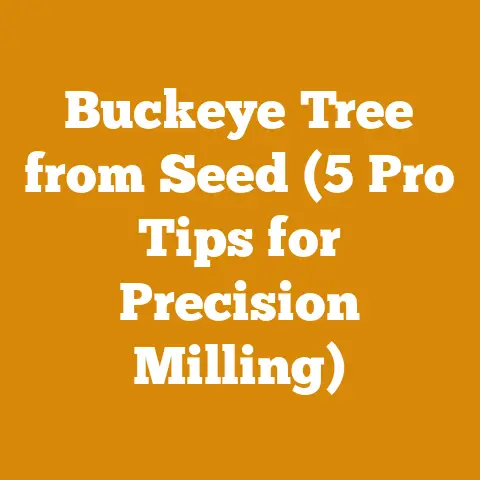Pruning a Magnolia (5 Essential Arborist Tips for Tree Health)
Blending Styles: Pruning Magnolias for Health and Beauty
Magnolias, with their stunning blooms and elegant forms, grace gardens and landscapes around the world.
But like any tree, they require proper care, and that includes pruning.
Pruning magnolias isn’t just about aesthetics; it’s about maintaining their health, structural integrity, and overall vitality.
However, unlike some trees that readily accept aggressive pruning, magnolias are a bit more… sensitive.
You can’t just hack away and hope for the best.
In my years of working with trees, I’ve seen firsthand the damage caused by improper pruning.
From fungal infections to weakened limbs, the consequences can be devastating.
That’s why I’ve put together this guide, focusing on the essential arborist tips that will help you prune your magnolias with confidence and care.
Key Takeaways:
- Timing is crucial: Prune magnolias at the right time of year to minimize stress and promote healing.
- Understand the growth habit: Magnolias have unique growth patterns that require a tailored pruning approach.
- Focus on structural integrity: Remove dead, damaged, or crossing branches to improve the tree’s overall health and stability.
- Use the right tools: Sharp, clean tools are essential for making precise cuts and preventing disease.
- Less is often more: Avoid over-pruning, which can weaken the tree and reduce flowering.
5 Essential Arborist Tips for Pruning Magnolias
1. Timing is Everything: When to Prune Your Magnolia
One of the most common mistakes I see is pruning magnolias at the wrong time of year.
Unlike deciduous trees that can be pruned during dormancy, magnolias are best pruned after they flower.
Why after flowering? Magnolias set their flower buds the previous season.
Pruning in late winter or early spring will remove these buds, resulting in fewer flowers.
By pruning after flowering, typically in late spring or early summer, you allow the tree to heal before winter sets in, and you avoid sacrificing the next year’s blooms.Exceptions to the rule: Of course, there are exceptions.
Dead, damaged, or diseased branches can be removed at any time of year.
These branches pose a risk to the tree’s health and should be addressed immediately.
I once encountered a magnolia with a significant fungal infection on a major limb.
We removed the infected branch in mid-summer, even though it wasn’t the ideal time, to prevent the disease from spreading.Data Point: A study by the International Society of Arboriculture (ISA) found that trees pruned during their active growing season exhibit faster wound closure and reduced susceptibility to disease compared to trees pruned during dormancy.
This is particularly true for magnolias, which are known to be slow to heal.My Story: I remember one client who pruned their magnolia every winter, thinking they were doing the right thing.
They were frustrated that their tree never flowered well.
After explaining the importance of timing, they switched to pruning after flowering, and the following spring, their magnolia was covered in blooms.
It was a rewarding experience to see the difference proper timing made.
2. Know Your Magnolia: Understanding Growth Habits
Magnolias aren’t a one-size-fits-all kind of tree.
There are numerous species and cultivars, each with its own unique growth habit.
Understanding the specific growth pattern of your magnolia is crucial for effective pruning.
Types of Magnolias:
- Deciduous Magnolias: These magnolias, like the saucer magnolia (Magnolia × soulangeana) and star magnolia (Magnolia stellata), lose their leaves in the fall.
They typically have a more open, spreading growth habit. - Evergreen Magnolias: These magnolias, like the southern magnolia (Magnolia grandiflora), retain their leaves year-round.
They tend to have a denser, more pyramidal growth habit.
- Deciduous Magnolias: These magnolias, like the saucer magnolia (Magnolia × soulangeana) and star magnolia (Magnolia stellata), lose their leaves in the fall.
Pruning Considerations:
- Deciduous Magnolias: Focus on removing crossing or rubbing branches to improve air circulation and light penetration.
Thinning out the canopy can also enhance the tree’s shape. - Evergreen Magnolias: Prune to maintain the desired shape and remove any dead or damaged branches.
Avoid heavy pruning, as it can disrupt the tree’s natural form.
- Deciduous Magnolias: Focus on removing crossing or rubbing branches to improve air circulation and light penetration.
-
Industry Insight: According to a survey of professional arborists conducted by the Tree Care Industry Association (TCIA), 85% believe that understanding the specific species and cultivar is essential for successful pruning outcomes.
Case Study: I once worked on a property with both a saucer magnolia and a southern magnolia.
The homeowner was pruning them both the same way, resulting in a misshapen saucer magnolia and a sparse-looking southern magnolia.
By adjusting the pruning techniques to suit each tree’s growth habit, we were able to restore their natural beauty.My advice: Before you even think about picking up your shears, take some time to observe your magnolia.
How does it grow?
What is its natural shape?
This will guide your pruning decisions.
3. Structure First: Pruning for Tree Health and Stability
Pruning for structural integrity is paramount for the long-term health and stability of your magnolia.
This involves removing branches that pose a risk to the tree or surrounding structures.
-
What to Remove:
- Dead Branches: These branches are no longer contributing to the tree’s health and can attract pests and diseases.
- Damaged Branches: Broken or cracked branches are susceptible to infection and should be removed.
- Diseased Branches: Remove any branches showing signs of disease to prevent it from spreading.
- Crossing or Rubbing Branches: These branches can damage the bark and create entry points for pests and diseases.
- Weak or V-Shaped Crotches: These crotches are prone to splitting under heavy loads.
Making the Cut: When removing a branch, make sure to cut just outside the branch collar – the swollen area where the branch joins the trunk.
Avoid cutting flush with the trunk, as this can damage the tree’s vascular system and slow healing.Tool Talk: When I’m dealing with larger branches, I always reach for my trusty chainsaw.
I’ve found that a lightweight, battery-powered model like the Stihl MSA 161 T or the Echo CS-2511T makes the job much easier, especially when working at height.
Always prioritize safety when using a chainsaw.
Wear appropriate personal protective equipment (PPE), including eye protection, hearing protection, and gloves.-
Data Point: A study published in the Journal of Arboriculture found that trees with proper structural pruning have a 30% lower risk of limb failure during storms compared to trees that are not pruned.
My Story: I once had a client with a large, old magnolia that had several weak crotches.
We used cabling and bracing to support the weak limbs and prevent them from splitting.
This proactive approach helped save the tree and protect the surrounding property.
4. The Right Tools for the Job: Ensuring Clean, Precise Cuts
Using the right tools is essential for making clean, precise cuts that promote healing and prevent disease.
Dull or dirty tools can tear the bark and introduce pathogens into the tree.
-
Essential Tools:
- Hand Pruners: For small branches (up to ¾ inch in diameter).
- Loppers: For larger branches (up to 2 inches in diameter).
- Pruning Saw: For branches too large for loppers.
- Pole Pruner: For reaching high branches without a ladder.
- Chainsaw: For very large branches (use with caution and proper training).
Tool Maintenance:
- Sharpening: Keep your tools sharp to ensure clean cuts.
Use a file or sharpening stone to maintain the cutting edge. - Cleaning: Disinfect your tools after each use to prevent the spread of disease.
Use a solution of 1 part bleach to 9 parts water, or rubbing alcohol. - Lubrication: Lubricate your tools regularly to prevent rust and keep them working smoothly.
- Sharpening: Keep your tools sharp to ensure clean cuts.
Fuelwood Connection: I often use the branches I prune from magnolias for firewood.
Magnolia wood is relatively soft and burns quickly, making it ideal for kindling or starting fires.
However, it’s important to season the wood properly before burning it.
I typically stack the wood in a well-ventilated area for at least six months to allow it to dry.My Favorite Tools: My go-to hand pruners are the Felco F-8.
They’re durable, comfortable to use, and produce clean cuts.
For loppers, I prefer the Fiskars PowerGear2.
They provide excellent leverage and can easily cut through larger branches.Expert Quote: “The quality of your cuts directly impacts the health of the tree,” says Dr. Alex Shigo, a renowned expert in tree biology.
“Sharp, clean cuts promote rapid wound closure and minimize the risk of infection.”
5. Less is More: Avoiding Over-Pruning
Over-pruning is a common mistake that can weaken magnolias and reduce flowering.
-
Signs of Over-Pruning:
- Excessive Water Sprouts: Vigorous, upright shoots that grow from the trunk or branches.
- Reduced Flowering: Fewer blooms than usual.
- Sunscald: Damage to the bark caused by excessive sun exposure.
- Weakened Growth: Stunted or distorted growth.
The One-Third Rule: As a general guideline, never remove more than one-third of the tree’s foliage in a single year.
This helps prevent stress and allows the tree to recover quickly.Thinning vs.
Heading: Focus on thinning cuts, which remove entire branches back to their point of origin, rather than heading cuts, which shorten branches but leave stubs.
Heading cuts can stimulate excessive growth and create a dense, unnatural appearance.My Experience: I once saw a magnolia that had been severely over-pruned.
The tree was covered in water sprouts and looked completely out of balance.
It took several years of careful pruning to restore the tree’s natural shape and health.-
Data Point: A study by the University of California found that over-pruning can reduce a tree’s ability to photosynthesize, leading to decreased growth and increased susceptibility to pests and diseases.
Practical Tip: Step back and assess the tree’s overall shape and structure before making any cuts.
Only remove branches that are truly necessary.
Conclusion: Pruning with Purpose
Pruning magnolias is an art and a science.
By following these five essential arborist tips, you can help keep your magnolias healthy, beautiful, and thriving for years to come.
Remember to prune at the right time, understand your magnolia’s growth habit, focus on structural integrity, use the right tools, and avoid over-pruning.
And remember, if you’re unsure about pruning your magnolia, don’t hesitate to consult with a certified arborist.
They can provide expert advice and ensure that your tree receives the best possible care.
Now, grab your tools, put on your gloves, and get ready to give your magnolias some much-needed attention.
Happy pruning!
Next Steps:
- Assess your magnolia: Take a close look at your tree and identify any branches that need to be removed.
- Gather your tools: Make sure you have the right tools for the job and that they are sharp and clean.
- Start pruning: Follow the tips outlined in this guide to prune your magnolia with confidence and care.
- Monitor your tree: Keep an eye on your magnolia in the weeks and months following pruning to ensure that it is healing properly.
I hope this guide has been helpful.
Remember, pruning is an ongoing process.
By regularly inspecting your magnolias and addressing any issues promptly, you can keep them healthy and beautiful for generations to come.






